The POWER of NAPS
Candler School of Theology alumna Tricia Hersey, founder of the Nap Ministry, is an evangelist for the importance of rest — not just as a way to be more productive, but also as a generative place to dream, become more aligned with yourself and resist grind culture.
BY KELUNDRA SMITH | ILLUSTRATION BY BECKI GILL
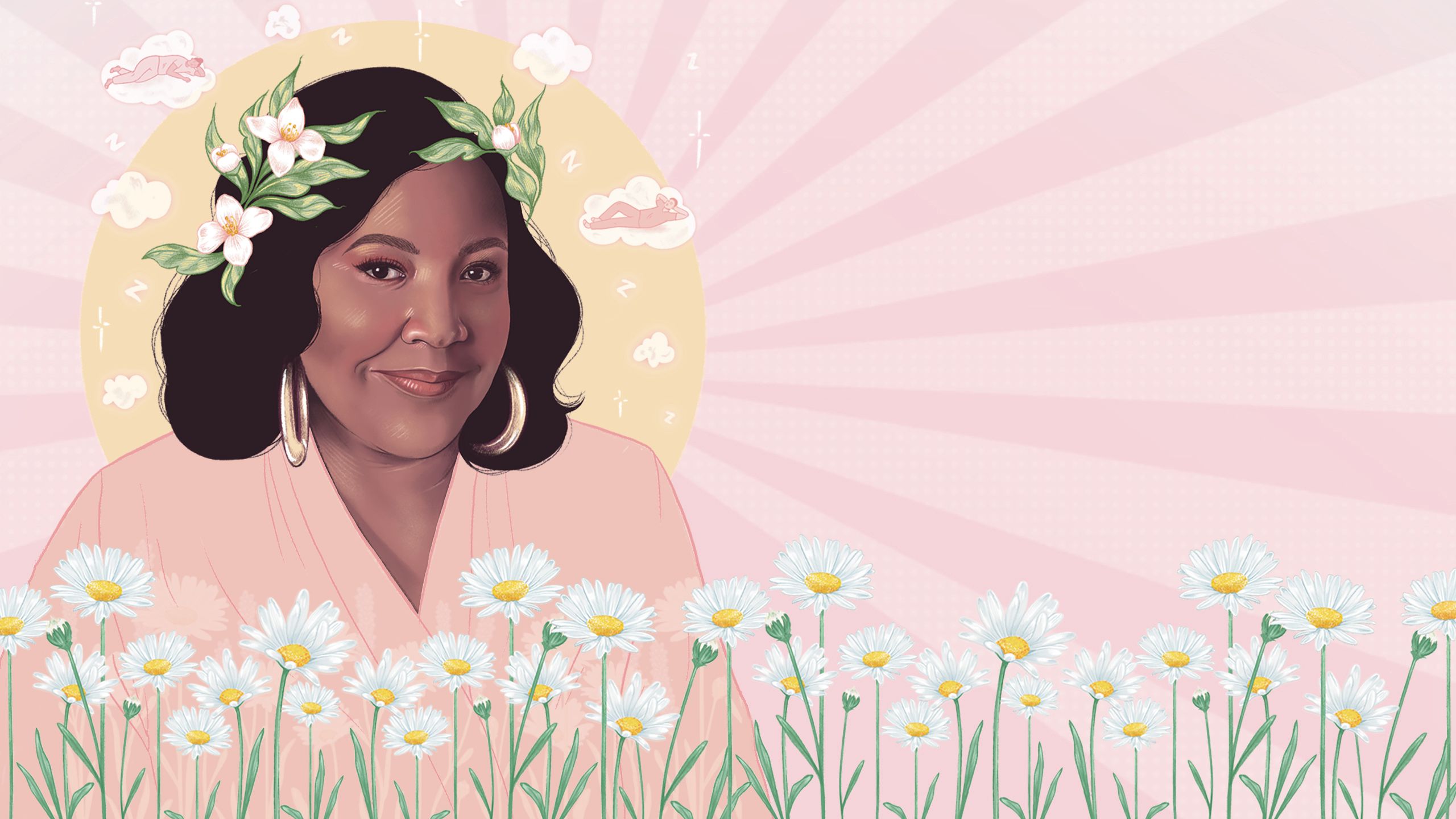
It was around 2014, and Tricia Hersey found herself bone-tired. It wasn’t the kind of tired that could be easily resolved by a spa visit or a girls’ weekend. It was the kind that had built up over decades and demanded a more drastic solution.
Enrolled at Emory’s Candler School of Theology, Hersey was working toward earning her master of divinity degree. Her schedule was filled to the brim. A typical day started at 5:30 a.m., waking up early to study before getting her son off to school. She had to take a bus and then a train to get to Emory for class. After three classes, she headed to her work-study job, and on some days, she also went to an internship. It was usually midnight by the time she got home. She had been doing this routine day in, day out for more than a year.
In Hersey’s New York Times best-selling book, “Rest Is Resistance: A Manifesto,” she recalls this time, writing, “During final exam season, I watched people live in the library, never once leaving, bringing sleeping bags to lie under tables and in between the bookshelves. I spent numerous times living in the library for overnight group study sessions with classmates during finals week.”
To cope with the stress of her long days — and nagging lack of sleep — Hersey started taking short naps on campus. She slept on the Quad, in Cannon Chapel, in the library, on any surface she could find. She fell asleep with books on her chest, which reminded her of her grandmother.
In her book, Hersey notes that Grandma Ora rarely sat still, but when she did it was to rest her eyes. What was her grandmother tapping into during those stolen moments of rest? Could she discover something while resting that she couldn’t while she was going through the motions?

Hersey found that the content inside the books seeped into her in a deeper way than when she was cramming to write papers. Rest also allowed her to imagine a different and better life for herself and her family. She didn’t have to do more to become more.
“Sleep is a generative space; it has helped everything make more sense,” Hersey says. “When I started to miss assignments, I got better grades. I was taking naps with books on me. I wasn’t reading them, but I was dreaming about it.”
Hersey started experimenting with rest and encouraged others to do the same. Then she hosted a collective napping experience as a project for her master’s degree. She expected a handful of people to come, but instead 50 people from the Emory community showed up. She decorated a space with pillows and mats on the floor and played soothing music. Attendees were invited to lie down and close their eyes while Hersey recited a guided meditation, giving everyone permission to rest.
When the one-hour experience was over, Hersey realized that she was onto something bigger. Something that would eventually lead to the Nap Ministry, which today boasts hundreds of thousands of followers — though not in the usual sense.
"Because I’ve been trained as an activist and organizer since I was 18 years old, I knew that no healing could take place alone,” Hersey says. “Everything is about community care and the collective. I wanted the experience to be offered collectively to resist and make a statement about the idea that we can be off the clock. We can bend time and slow down.”

REST AS SOCIAL JUSTICE
Before she uncovered the power of rest, the constant anxiety created by systemic prejudice compounded by the stress of juggling motherhood, work and graduate school had left Hersey feeling drained. But it was the type of sacrifice she had known most of her life. She grew up on Chicago’s South Side witnessing her parents working themselves to the bone to give to those in need.
When Hersey enrolled at Candler, she thought about becoming an ordained minister who would take the community justice work her family did to a heightened level. However, two important books she read at Emory changed Hersey’s perspective on what ministry could look like.
First, she read the 1969 book “Black Liberation Theology” by James H. Cone, which was published in the midst of the Black Power, Black Arts and Black Is Beautiful movements of the late 1960s and early 1970s. In the book, Cone talks about Christianity from the perspectives of Black people who see God as aligned with justice, freedom and abundance. “Black Liberation Theology” presents religion as a bridge to liberation from oppression.
Hersey also read “Slave Testimony: Two Centuries of Letters, Speeches, Interviews, and Autobiographies” by John W. Blassingame, a 1977 book that compiles testimonials from enslaved Africans talking about plantation life. They worked 16 to 18 hours per day with very little to eat or drink. They describe the aches and pains in their bodies from the expectations of working virtually nonstop. Picking cotton, rice, tobacco and sugar cane in this way was the fate of many African Americans up until the mid-1900s when widespread technology started to transform agricultural production.
She saw too many parallels between the lived experiences of her ancestors and her own family. She was barely getting five hours of sleep trying to trying to manage all her responsibilities — while taking public transportation because she sold her car to help pay for graduate school. During this time, Hersey often thought about her father, elder Willie J. Hersey, whom she watched spend decades working long hours for the railroad and then ministering to the sick and weary on nights and weekends. He died far too young from complications after a triple bypass heart surgery at the age of 55.
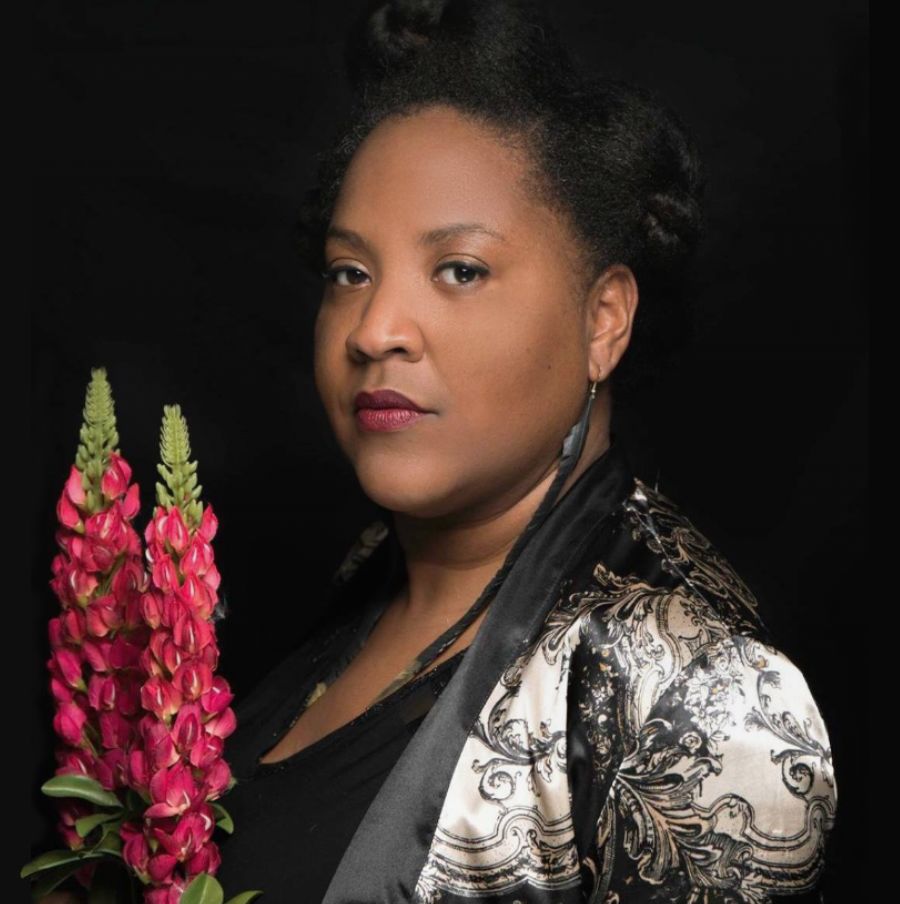
Hersey also realized how social media culture glamorized endless work. Posts and images carrying the hashtags #RiseandGrind and #TeamNoSleep flooded her newsfeed. Grind culture, which Hersey describes as a collaboration between capitalism and white supremacy, was taking over. The idea of not sleeping until death was one that her ancestors and elders suffered under for centuries, and it didn’t sit well in her soul.
From childhood, like many of us growing up in the U.S., she had been taught that if she got good grades, worked hard and did the right thing, she would prosper. But she learned from her family and the Black community that there were systemic factors and biases — often superseding merit and hard work — that determined who got to achieve material success and who didn’t. After all, Hersey was constantly working and still barely keeping the lights on. “The idea of connecting your worth to how much you get done and the socialization and brainwashing of grinding starts at birth,” Hersey says. “In ‘Rest Is Resistance,’ I talk about my son, and how the culture teaches us to ignore our bodies as children. Perfectionism is a tenant of white supremacy work culture. It has us all in a chokehold.”
A culture built on “humans working at a machine-like pace,” as she describes it, felt dangerous. The idea that people were only created to serve a capitalist economic system was out of line with everything she had been taught as a child about God as a keeper, protector, deliverer and stronghold. Something had to give.
“I think we need to distance ourselves from any system that is trying to suppress us,” Hersey says. “If you realize that you are a divine human being, there’s a leaping.”
However, there was one thing that had never failed her, and that was her imagination. Hersey is a trained puppeteer who used to perform at the Center for Puppetry Arts in Atlanta. She is also a poet and writer. While at Emory, Hersey took additional classes in the dance and theater departments. For her, art and spiritual well-being are connected, and part of her work at Candler was trying to figure out how she could blend art and ministry.
And it’s at the intersection of art and spirituality that the Nap Ministry came to be.

REST AS RESISTANCE
After that first collective napping experience Hersey led in graduate school, word spread fast and demand grew. The self-proclaimed Nap Bishop started hosting collective nap experiences at Yellow Mat Yoga and then at a Presbyterian church in Grant Park. She also posted affirmations and proclamations on social media to spread her message about resting.
If churches and temples are supposed to be places to connect, be inspired and build community, then the Nap Ministry is gaining parishioners daily. It currently boasts more than 500,000 followers on Instagram, but unlike social media influencers, Hersey’s goal is not to gain more followers. She actually wants people to log off and rest.
“Rest Is Resistance: A Manifesto” was published by Little Brown, Spark in October 2022 and quickly became a critically acclaimed bestseller. The book is dedicated to Hersey's father, who she thanks for purchasing luggage from Sears when she said she wanted to go to the moon. In the book, she describes how naps have changed her life, how she began to deprogram her mind and body from grind culture and the importance of accessing “the dream space.”
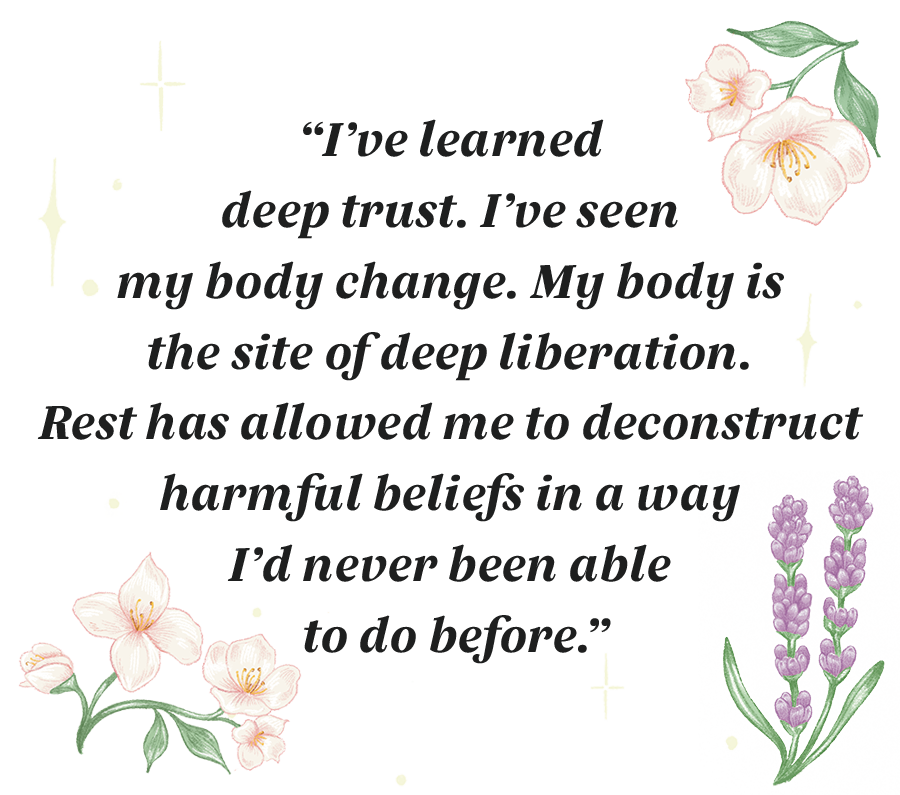
“Rest has taught me that God is in control, and I’ve always known that,” Hersey says. “I’ve learned deep trust. I’ve seen my body change. My body is the site of deep liberation. Rest has allowed me to deconstruct harmful beliefs in a way I’d never been able to do before.”
As a manifesto, the book features repeated mantras throughout, such as “Our collective rest will save us,” and "You must resist anything that doesn’t center your divinity as a human being.” These meditations and affirmations aren’t meant to be sticky notes that collect dust, but rather to serve as catalysts to change hearts and minds.
“This is an invitation for people to heal from individual and collective trauma,” Hersey says. “Everything that has caused a degrading of your divinity must be healed. It’s about being an outlier.”

REST AS A BIRTHRIGHT
Nowadays, Hersey travels around the world hosting collective napping experiences and advocating for rest. During those experiences, she invites people to find a spot to lie down, takes them through a centering and breathing exercise and encourages them to sleep. She’s made a couple of stops at Emory along the way, including a virtual visit to art history professor Dana Haugaard’s class in 2021.
Hersey also developed the Resurrect Rest School, where she has reading and rest sessions for people looking to liberate themselves from grind culture. Still, with increased asks of her time, energy and talents, Hersey says she turns down 90% of the requests she receives — and rests for at least three hours per day.
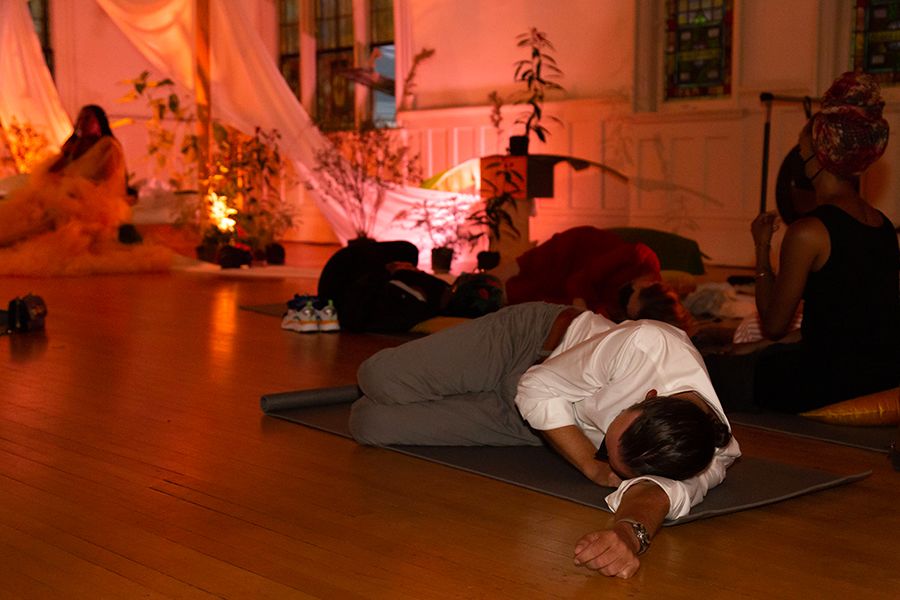
“Even before I started the Nap Ministry, I believed in saying ‘no,’” Hersey says. “I’ve done a lot of healing work around the need to be a people pleaser. People have been brainwashed to believe there is a four-step way to get to healing or liberation, but this is a lifelong wellness practice.”
Looking back on her time at Emory, Hersey says she is grateful for the community she found here. Classes with professors Teresa L. Fry Brown and Robert M. Franklin Jr. made being an African American student in her program less lonely.
She also found solace in her peers and in the knowledge that she was not alone in her struggles. Looking back, she has a bit of advice for current students.
“I would’ve told myself it’s okay to fail,” Hersey says. “Failing has been a major beautiful lesson for me. Once you understand that it’s okay, it’s a part of our experimentation as humans. We’re taught to be perfect and follow the rules, but I would have told myself to be more expansive in my thinking. Failure has taught me the most as an artist, scholar and mother.”

Slumber Time
Can't rest? Reading these guides will put you to sleep—on purpose.
Tricia Hersey, founder of the Nap Ministry, reached a mainstream audience with her teachings when she published “Rest Is Resistance: A Manifesto” last fall. The book, which quickly became a New York Times bestseller, encourages readers to take naps, rest and daydream to heal from the daily grind of doing it all. It also inspires readers to push back against capitalistic — and racial — oppression that expects us to toil relentlessly and exploits “the same engine that enslaved millions into brutal labor for its own relentless benefit.”
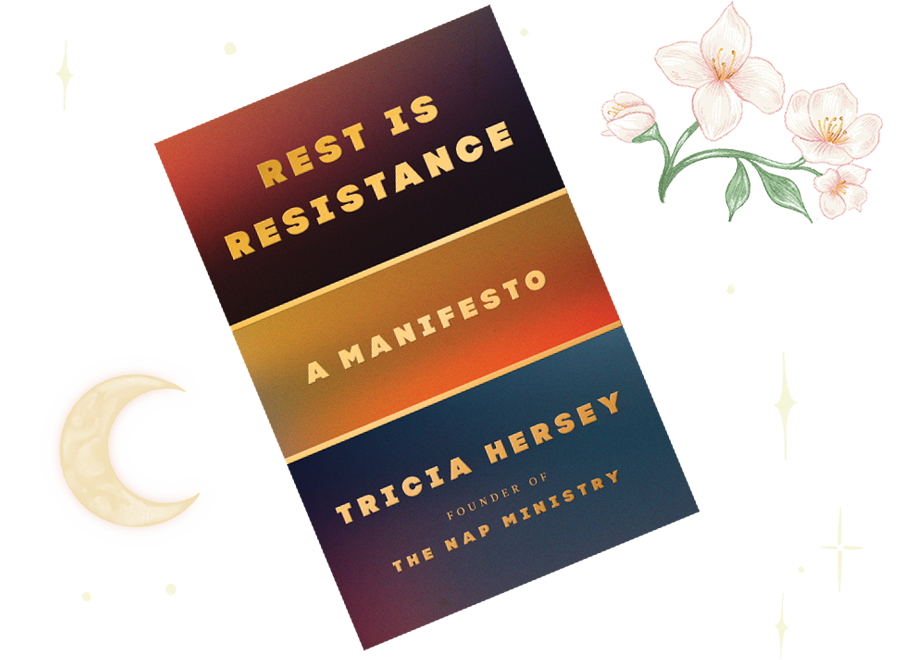
Throughout the pages of her manifesto, Hersey calls out our problematic approach to rest and shines a light on how to use napping as a catalyst for imagining and dreaming our way to a new state where rest is celebrated rather than looked down upon as laziness. She shares the story of how she grew to realize that our worth shouldn’t be tied to how much we “produce” — especially in a system that grinds us down — and teaches readers how we should exalt in our humanity and reclaim our power as an act of resistance.

This spring, the Nap Bishop — as she calls herself — released a card deck packed with 50 powerful rest practices to help readers embrace rest as a form of self-care and personal liberation. Each of the beautifully illustrated cards comes with an empowering affirmation and a simple practice geared to foster rest and imagination. Rooted in social justice and infused with spirituality, these cards are designed to uplift anyone suffering from the toxic effects of grind culture.
Both “Rest Is Resistance: A Manifesto” and the Nap Ministry’s Rest Deck are available for purchase at Amazon and other popular booksellers.
Want to know more?
Please visit Emory Magazine, Emory News Center, and Emory University.

